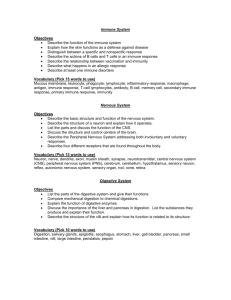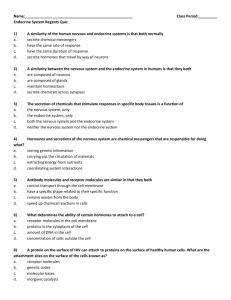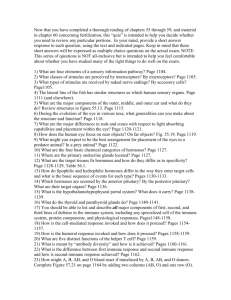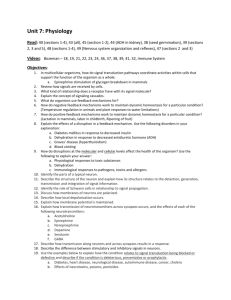The Human Body - Background Notes 10-12
advertisement
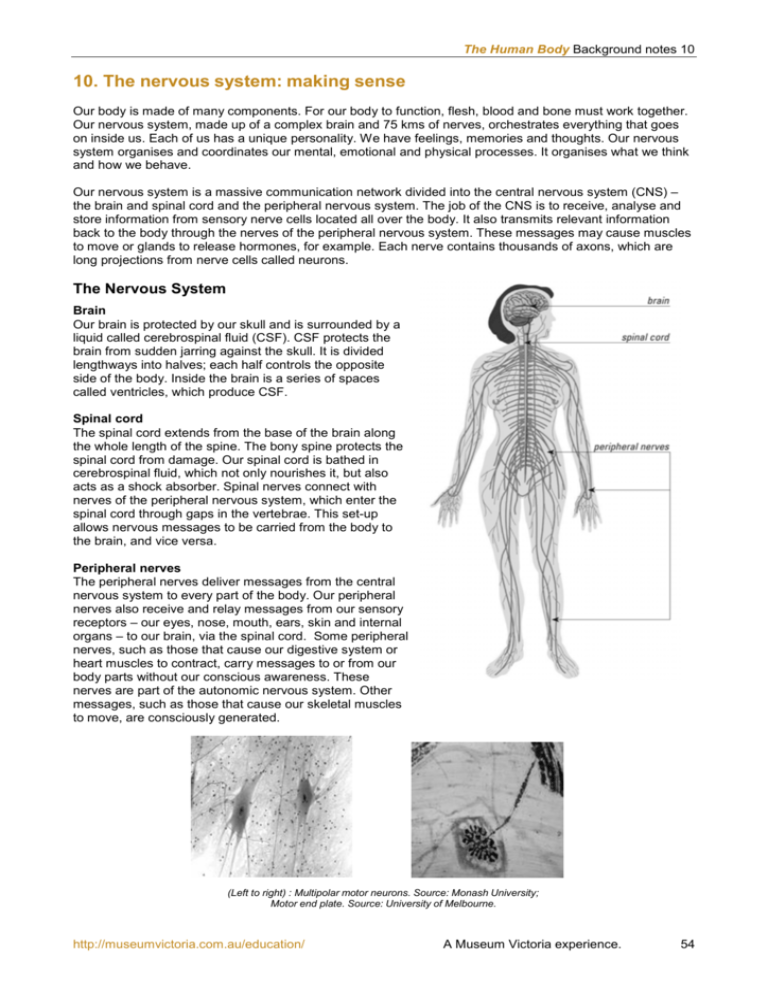
The Human Body Background notes 10 10. The nervous system: making sense Our body is made of many components. For our body to function, flesh, blood and bone must work together. Our nervous system, made up of a complex brain and 75 kms of nerves, orchestrates everything that goes on inside us. Each of us has a unique personality. We have feelings, memories and thoughts. Our nervous system organises and coordinates our mental, emotional and physical processes. It organises what we think and how we behave. Our nervous system is a massive communication network divided into the central nervous system (CNS) – the brain and spinal cord and the peripheral nervous system. The job of the CNS is to receive, analyse and store information from sensory nerve cells located all over the body. It also transmits relevant information back to the body through the nerves of the peripheral nervous system. These messages may cause muscles to move or glands to release hormones, for example. Each nerve contains thousands of axons, which are long projections from nerve cells called neurons. The Nervous System Brain Our brain is protected by our skull and is surrounded by a liquid called cerebrospinal fluid (CSF). CSF protects the brain from sudden jarring against the skull. It is divided lengthways into halves; each half controls the opposite side of the body. Inside the brain is a series of spaces called ventricles, which produce CSF. Spinal cord The spinal cord extends from the base of the brain along the whole length of the spine. The bony spine protects the spinal cord from damage. Our spinal cord is bathed in cerebrospinal fluid, which not only nourishes it, but also acts as a shock absorber. Spinal nerves connect with nerves of the peripheral nervous system, which enter the spinal cord through gaps in the vertebrae. This set-up allows nervous messages to be carried from the body to the brain, and vice versa. Peripheral nerves The peripheral nerves deliver messages from the central nervous system to every part of the body. Our peripheral nerves also receive and relay messages from our sensory receptors – our eyes, nose, mouth, ears, skin and internal organs – to our brain, via the spinal cord. Some peripheral nerves, such as those that cause our digestive system or heart muscles to contract, carry messages to or from our body parts without our conscious awareness. These nerves are part of the autonomic nervous system. Other messages, such as those that cause our skeletal muscles to move, are consciously generated. (Left to right) : Multipolar motor neurons. Source: Monash University; Motor end plate. Source: University of Melbourne. http://museumvictoria.com.au/education/ A Museum Victoria experience. 54 The Human Body Background notes 10 The brain Our brain has hundreds of billions of neurons, each connected to hundreds of other neurons. With trillions of neural connections, our brain is able to process an enormous amount of information very quickly. As we experience life, our brain stores information as memories. Each person has unique experiences and memories. Our brain’s short-term memory, like holding such information as a phone numbers, soon fades. Our long-term memory may hold information, like a popular tune or how to ride a bike, for a lifetime. Memories are not stored in one location in the brain. Our memory is found in various locations scattered all over the surface of our brain. The thinking brain: the cerebral cortex This is the grey outer layer of the brain, often referred to as grey matter. It stores memories, solves problems, and tells muscles when to contract. It is the part of our brain associated with intelligence and complex behaviour. The sensitive brain: the somatosensory cortex This part of the brain receives nerve impulses from sensory neurons in our body, especially the skin. It receives and monitors information about our environment and relays this information to other parts of the brain. The balanced brain: the cerebellum This part controls the body’s balance and coordination. It receives information from sensory nerves that tell it what the body is doing and it sends messages back to control the muscles in response to this information. The perceptive brain: the thalamus All of our sensory information, from our sensory nerves and receptors, comes into the brain via this part of the brain. It filters out the information that is important from that which is not. Pain is detected by this part of the brain. The developmental brain: the hypothalamus This part regulates many important body functions such as our temperature, salt and water input and output, our emotions and hormones and when we reach puberty. The remembering brain: the hippocampus This part of our brain allows us to remember things from our past, to learn and be motivated. It allows us to express our feelings and emotions. The regulatory brain: the brain stem This is the basic control centre of the brain. It controls sleep and arousal, our heart rate respiration and digestive processes. It is also responsible for our basic body reflexes. http://museumvictoria.com.au/education/ A Museum Victoria experience. 55 The Human Body Background notes 10 Nerve cells are called neurons Nerve cells are called neurons. They are the cells that relay messages in the brain and the nervous system. Neurons have a large star-shaped cell body with a nucleus inside. Dendrites are small finger-like extensions that extend from the cell body, making connections and receiving input messages from surrounding nerve cells and tissue. An axon is a long process, that may extend to a metre in length that carries electrical messages from the neuron to other cells, tissues and organs of the body. These are the signals that tell the body what to do and how to respond to the environment. Neurons have different shapes depending on where they are, where they send messages to and what messages they are conveying. Sensory neurons detect stimuli from internal tissues and organs and external stimuli that affect the body. They allow us to detect smell, light (sight), taste, sound (hearing), and changes in our body position due to gravity (balance). There are also general sensory nerve receptors, such as those for pressure (touch), temperature and pain. Motor neurons conduct impulses from the central nervous system, through myelinated axons that travel to muscle tissue in the body to make them contract (Left to right) : Brain neuron, motor neuron, sensory neuron. A neuron stained with a fluorescent dye. Like many neurons this cell has lacy dendrites that receive impulses and the main axon that carries impulses to other cells. Source: John Wiley & Sons, STM Journal Production. Alive with electricity Nerves are like cables, with nerve axons as the individual strands. Messages flash along axons at 400kph, as tiny electrical impulses. Each impulse is triggered by a stimulus, such as heat or a chemical. Impulses are transmitted from one neuron to the next across a small gap, called a synapse. When an impulse reaches the end of a neuron, a chemical is released into the synapse. This chemical, called a neurotransmitter, triggers an electrical impulse in the next neuron, and so the message continues. Nerve impulses travel in only one direction along a neuron otherwise the nervous system would collapse in a confusion of messages. This illustration shows a cut away of a nerve ending releasing neurotransmitters that diffuse across the synapse and bind to the next cell. This may initiate an electrical event in another neuron or cell. http://museumvictoria.com.au/education/ A Museum Victoria experience. 56 The Human Body Background notes 10 Neurotransmitters: mind-altering chemicals Neurotransmitters are chemicals that control how nerve cells communicate with each other to process information and send messages to the rest of the body. They can stimulate or reduce the nerve impulse that is travelling along a certain nerve path. Neurotransmitters are central to memory, learning, mood, behaviour, sleep, pain perception and sexual urge. There are many different neurotransmitters. Serotonin and dopamine affect our mood, and endorphins reduce our perception of pain. The neurotransmitters, glutamate and GABA are important to many brain functions, from memory to sleep. Many drugs act by mimicking or interrupting the effect of neurotransmitters in the brain. Neurons need care and defence Nerve cells can live for over 100 years. A network of supporting cells ensures that nerve cells receive nutrients and are protected from infection. Astrocytes are cells found in large numbers in brain tissue. They exchange nutrients between the blood and brain tissue, and service neurons so they remain strong and healthy. Astrocytes are star shaped and have long branching extensions that wrap around blood vessels and the nerve cells that they are servicing. Myelin sheaths insulate nerve bundle and allow electrical nerve messages to travel along nerve axons very quickly. The thick myelin sheath that surrounds nerve axons is shown in the image above. Source: University of Melbourne Microglial cells are small cells that occur in the brain in relatively small numbers. They have a tiny nucleus inside a very small cell body. They also have many highly branched feathery processes that extend from the cell body and connect to surrounding tissue. They respond to tissue damage by transforming into large defender cells that engulf and destroy invading cells and damaged tissue. When things go wrong: Alzheimer’s Disease Alzheimer’s Disease causes irreversible degeneration of the brain. Over time, people with Alzheimer’s suffer loss of memory, confusion and a reduced attention span. As the disease progresses, loved ones are no longer recognised, and even language is lost. These symptoms usually appear over several years and are due to changes in parts of the brain that deal with thinking and memory. Examination of affected brains shows that neurons become tangled into clumps and eventually die and the protective myelin sheath may also deteriorate. Although usually seen in elderly people, Alzheimer’s disease may begin in middle age. http://museumvictoria.com.au/education/ A Museum Victoria experience. 57 The Human Body Background notes 11 11. The hormonal system: the messengers Hormones have powerful control over our bodies. They are invisible chemical messengers made by our endocrine glands, which secrete their content into the blood stream. Hormones keep us alive by maintaining the balance of nutrients in our blood, as well as regulating our energy levels. They influence the way our bodies develop and grow. They may be tiny, but hormones have a huge influence in the way our bodies work. Our bodies produce many different hormones. A hormone influences whether a particular cell will produce a substance or not. It can control whether our cells will grow and divide, or move around the body, or when they might die. Different hormones affect different target cells. Some hormones, called growth factors, target cells that are very close to where they are released. Others might have an effect at remote sites around the body. Hormone secreting glands and organs Glands are organs of the body that are designed specifically to produce hormones. Some of these glands are quite small. Some organs produce hormones as well as perform other functions in the body. The Pituitary gland is a pea-sized gland attached to the brain by a stalk and it sits in a bony cavity. The pituitary gland releases at least eight different hormones. One of these is growth hormone, which is important for our growth. The Pineal gland is a tiny gland located deep within the brain. It produces melatonin, which helps regulate our body clock and body rhythms. The Thyroid gland is shaped like a butterfly and wraps around the trachea. It produces thyroid hormone, which regulates our energy levels. The Parathyroid glands are so small we can hardly see them. They are attached to the back of the thyroid and secrete parathyroid hormone, which controls the levels of calcium in our bodies. The Adrenal glands are attached to the top of each of our two kidneys. These glands release adrenaline to increase our heart rate and blood pressure and enable us to deal with physical, emotional and mental stress. The Hypothalamus is a region of the brain that produces a variety of hormones, including those responsible for the onset of puberty such as gonadotrophin-releasing hormone, which controls the production of sex hormones. The Pancreas produces substances important for the digestion of our food together with the hormones insulin and glucagon which together regulate our blood sugar levels. The Testes produce sperm in men, as well as the male sex hormone testosterone, which promotes sexual development. Gland tissue has ducts into which hormones are secreted into. http://museumvictoria.com.au/education/ The Ovaries are responsible for the production of eggs in women, but they also produce the female sex hormones oestrogen and progesterone crucial for the sexual development of women. A Museum Victoria experience. 58 The Human Body Background notes 11 Reaching their target To have an effect, hormones must reach their target cells. A target cell has receptors on its surface, or inside it, to which a hormone attaches. Hormones travel in the blood until they bind to the receptors of their target cells. Some receptors are located on the cell surface. When a hormone binds to its receptor it sets off a series of responses within the target cell. Other hormones are able to slip through the cell membrane and bind to receptors within the target cell. Many drugs act by blocking or mimicking the binding of hormones to receptors. This is because they are similar in shape to the hormone. The drug ephedrine affects our bodies very much like the naturally occurring hormone adrenaline. Ephedrine binds to the adrenaline receptor and mimics its actions. Ephedrine is used as a nasal decongestant. When things go wrong Not enough hormone – Insulin and diabetes After a meal, when blood sugar levels are high, the pancreas releases the hormone insulin. Insulin stimulates our fat and muscle cells to absorb glucose from the blood. Our pancreas releases about 2 milligrams of insulin into our bloodstream daily. This means that a teaspoonful of insulin (about 15 grams) would be enough to regulate glucose levels for a period of 25 years. Diabetes mellitus type 1 is a hormonal disorder caused when the pancreas does not produce insulin. People that have diabetes mellitus type 1 must inject insulin regularly to ensure that their cells get enough glucose to function properly. Too much hormone – Testosterone and anabolic steroids Anabolic steroids are drugs that act like the male hormone, testosterone. One effect of testosterone is to promote muscle growth. The side effects to steroid use include aggressive behaviour, high blood pressure, liver damage, menstrual problems in women, and impotence in men. http://museumvictoria.com.au/education/ A Museum Victoria experience. 59 The Human Body Background notes 12 12. The immune system: the defenders The Immune System Bacteria, viruses and parasites may cause disease if they enter our bodies. Our skin and the membranes that line our body openings are excellent protective barriers. They are the first-line of defence against invaders. However, sometimes germs get through and our immune system protects us against these intruders. Our immune system also recognises and destroys sick or damaged cells of the body. It is primarily made up of white blood cells, which recognise and protect healthy cells that belong to our body and wage war against anything else. White blood cells – Our protectors Cells have distinctive membranes that are recognised by our immune system. The cells in our immune system can distinguish between foreign cells, bacteria, viruses and those belonging to the body. Foreign cells are attacked and body cells are left alone. White blood cells play a major role in immunity. They patrol our whole body, but are concentrated in the lymph nodes and lymphatic system. Lymph, lymph vessels and lymph nodes Some of the fluid that baths the tissues of the body returns directly to the blood. The rest is collected into open ended lymph vessels that drain this lymph fluid through a network of progressively larger vessels. The lymph is then filtered and cleaned as it passes through lymph nodes Lymph nodes are filled with immune cells (lymphocytes and macrophage) that wait to destroy invaders. Clusters of lymph nodes are located in the neck, armpits, groin and gut. The clean lymph is eventually drained back into the bloodstream. The thymus The thymus lies close to the heart. It is large in childhood when it is most active however it stops growing at adolescence and starts to shrink. By old age it is hardly noticeable. The thymus is where immune cells called T cells develop. It is within the thymus that T cells learn to react to foreign invaders and not to the body’s own cells. The spleen The spleen is covered in a thin membranous capsule that can be ruptured by a sharp blow or a severe infection. It is responsible for cleaning the blood by removing old blood cells, debris, bacteria, viruses and toxins. The spleen also stores white blood cells (lymphocytes). The bone marrow Blood cells don’t last forever. In time they have to be replaced by new ones. Bone marrow is a major site of white and red blood cell production. Growth factors produced by cells in the marrow stimulate the growth and activation of immune cells. http://museumvictoria.com.au/education/ A Museum Victoria experience. 60 The Human Body Background notes 12 The Non Specific Immune Response - fast and furious A particular group of white blood cells and white cell products respond immediately to injury and attack by a wide range of invaders. Macrophages, neutrophils and killer cells play a major role in the immediate non-specific immune response to tissue injury, inflammation and infection. Macrophages hunt down and engulf dead cells and foreign invaders all over the body. This process is called phagocytosis. Once inside the macrophage the particle is digested by corrosive chemicals that are stored in lysosomes. Macrophages also secrete substances called cytokines, which attract other immune cells to the site of infection. Immunological cell products are also released in response to tissue invasion and inflammation. Interferon is a group of proteins that defend the body against viral invasion. The Complement System is another group of proteins activated by the immune system, to attack foreign cells by attaching to their membrane. Macrophage engulfing particles. Source: California Institute of Technology Platelets: sticking and plugging Platelets are flattened cell fragments. They plug holes in broken blood vessels and are very important in the inflammatory and repair process of injured tissue. What’s pus Pus is a mixture of dead and dying neutrophils, dead tissue cells, and living and dead infectious agents. Inflammation When body tissues are injured, a general (or non-specific) immune response called inflammation occurs. http://museumvictoria.com.au/education/ Platelets are produced in bone marrow from large cells called megakaryocytes. Source: Peter MacCallum Cancer Institute A Museum Victoria experience. 61 The Human Body Background notes 12 The Specific immune response - slow and steady The specific immune response refers to the activation of lymphocytes to attack specific invading cells that the body has encountered before and is now primed to recognise and specifically attack and destroy. There are two types of specific immune responses: the cell-mediated response is activated by T lymphocytes (T cells); and the antibody-mediated response activated by B lymphocytes (B cells). Cell-mediated immune response T cells recognise certain bacteria and viruses, and they kill cells that may be infected by them. They also attack body cells that are cancerous or damaged. A particular group of T cells, called killer T cells, attach to infected or foreign cells and releases substances that kill them. Antibody-mediated (humeral) immune response Any foreign body or particle that enters the body and can potentially cause harm, is referred to as an antigen - bacteria, bacterial toxins, viruses and foreign tissues. When a specific antigen enters the body, B cells respond by producing proteins called antibodies. These antibodies attach themselves to the antigen and form an antibody-antigen complex. Antibodies can cause antigen destruction in different ways: 1. An antibody may transform the shape of a toxic chemical in such a way that it cannot enter cells of the body or cause detrimental affect to them. This is called antibody neutralisation. 2. Sometimes antibodies cross-link with many cellular antigens in a process called agglutination, to form large clusters or clumps of antigens – for example bacterial cells or even foreign blood cells. Non-specific immune cells are then relied upon to digest and remove these clusters from the body. 3. The most important role of antibodies however is to assist and enhance the role of the bodies non-specific immune responses. This occurs when antibody-antigen complexes activate the complement system, enhance phagocytosis by macrophage and neutrophils and activate cell lysis by natural killer cells. (Left to right) : Magnification of a lymphocyte in amongst blood cells. Source: University of Melbourne; B cells secrete unique antibodies that protect against specific foreign agents. The DNA code for every new antibody is stored in the B cells genetic memory, its DNA. If the body has no memory of a particular antigen it must make antibodies against it from scratch. This, however, can take several days. In the case of first time infections, especially if the pathogen is virulent or if the individual’s nonspecific immune system is weak, the invading organisms may be able to multiply and cause disease symptoms within the time it takes for the body to make specific antibodies against it. http://museumvictoria.com.au/education/ A Museum Victoria experience. 62 The Human Body Background notes 12 What invaders? Bacteria Bacteria are single cell organisms that divide rapidly. They are a vital part of our planet although a few kinds of bacteria can be harmful if they enter our bodies. These bacteria can multiply rapidly inside the body and release poisons, which affect the body in distinctive ways. Viruses Viruses are unique organisms. They do not consist of cells. Many scientists dispute whether or not they should be classified as living things at all. This is because these tiny infective organisms – simply comprised of a small strand of genetic material surrounded by layers of a protein capsule – can only reproduce and complete their lifecycle when they inject their genetic material into a host cell. Not all viruses are detrimental to human health. Some viruses can lay dormant inside a cell and have relatively no affect on our cells or our health. Other viruses target specific cells of the body and multiply by tricking the cells to replicate their genetic material. The cell also, unknowingly, makes new virus capsules. When the replicated viral DNA is packaged into the new capsules, the virus kills the cell by bursting out of it. The new viruses infect new cells, and the process continues, often resulting in specific disease patterns that we are able to recognise. Life cycle of a virus – infecting a cell, multiplication and cell lysis (breakdown). Source: Janssen – Cilag Pty Ltd When things go wrong Cancer Most cells are unable to divide more than a few times. Cancer cells, however, divide uncontrollably to form a mass of cells that invades surrounding tissue. Cancer cells are often recognised by our immune system as being foreign. However, sometimes these cells reproduce very rapidly and overwhelm our bodies’ defences. Auto-immunity The immune system can turn against itself. Our bodies can produce antibodies and sensitised T cells that destroy our own tissues. This phenomenon is called an auto-immune disease. Immunodeficiency Immunodeficiency occurs when the immune system isn’t working properly. When this happens, the body's defences against bacteria, viruses and parasites are weakened. There are many degrees of immunodeficiency and many triggers. The immunodeficiency of most concern today is AIDS (acquired immunodeficiency syndrome), which is caused by a virus called HIV (human immunodeficiency virus). This virus enters the body by blood transfusions, or blood-containing needles, or during intimate sexual contact that may allow the virus access to blood. HIV destroys a particular group of immune cells called T cells. In time, AIDS makes the immune system unable to protect the body against infection. http://museumvictoria.com.au/education/ A Museum Victoria experience. 63




